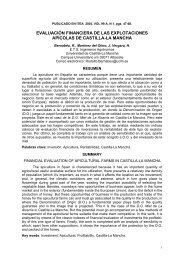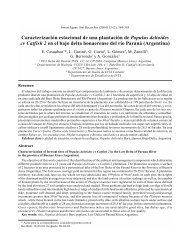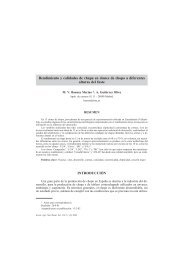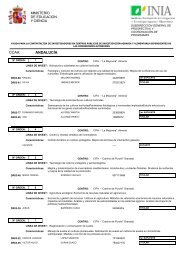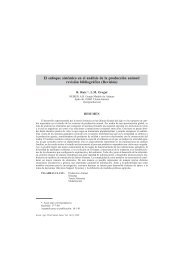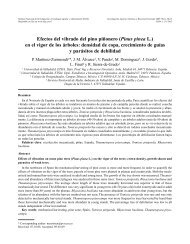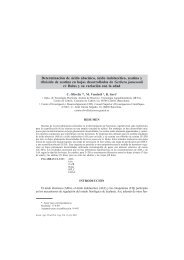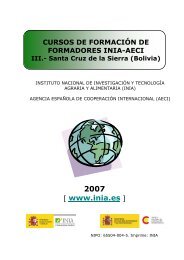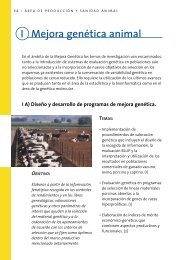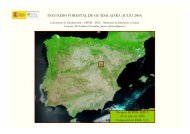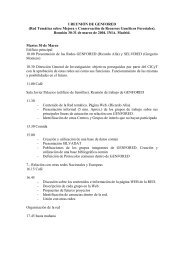Status of medicinal and aromatic plants in - Inia
Status of medicinal and aromatic plants in - Inia
Status of medicinal and aromatic plants in - Inia
You also want an ePaper? Increase the reach of your titles
YUMPU automatically turns print PDFs into web optimized ePapers that Google loves.
126<br />
WORKING GROUP ON MEDICINAL AND AROMATIC PLANTS: FIRST MEETING<br />
A new research project was started to conserve natural habitats <strong>and</strong> obta<strong>in</strong> st<strong>and</strong>ard<br />
natural dye extracts. Agronomic <strong>and</strong> chemical characters <strong>and</strong> dy<strong>in</strong>g properties <strong>of</strong> three dye<br />
<strong>plants</strong>, woad (Isatis t<strong>in</strong>ctoria), madder (Rubia t<strong>in</strong>ctorum) <strong>and</strong> weld (Reseda luteola), provid<strong>in</strong>g<br />
three ma<strong>in</strong> colours (blue, red <strong>and</strong> yellow, respectively) will be <strong>in</strong>vestigated.<br />
Indigenous knowledge<br />
The <strong>in</strong>digenous knowledge on usage <strong>of</strong> MAPs as folk remedies is gett<strong>in</strong>g lost ow<strong>in</strong>g to<br />
migration from rural to urban areas, <strong>in</strong>dustrialization <strong>and</strong> changes <strong>in</strong> life style. The Aegean<br />
region <strong>in</strong> Turkey is one <strong>of</strong> the areas most affected by <strong>in</strong>dustrialization. A new project was<br />
<strong>in</strong>itiated to collect <strong>and</strong> record the <strong>in</strong>formation on MAPs used as folk remedies.<br />
Possible cultivation methods for orchid species<br />
The use <strong>of</strong> salep (ground orchids bulbs) has a long history <strong>in</strong> Turkey. It is estimated that<br />
about 20 million orchid bulbs are collected annually <strong>in</strong> Turkey. This figure clearly shows<br />
that population density decreased dramatically due to annual harvest<strong>in</strong>g from the wild. A<br />
new research project aims to f<strong>in</strong>d out cultivation methods for salep orchids.<br />
Genebank activities<br />
Target areas <strong>and</strong> species are determ<strong>in</strong>ed every year. Herbarium samples collected from<br />
those areas are submitted to the genebank. In addition, seed multiplication is carried out for<br />
seed lots hav<strong>in</strong>g <strong>in</strong>sufficient or weak germ<strong>in</strong>ation rates. Characterization <strong>and</strong> evaluation<br />
studies for selected species are also conducted for the genebank.<br />
Sem<strong>in</strong>ars <strong>and</strong> tra<strong>in</strong><strong>in</strong>g courses<br />
Sem<strong>in</strong>ars <strong>and</strong> tra<strong>in</strong><strong>in</strong>g courses on MAP cultivation for Extension Service experts <strong>and</strong> farmers<br />
are held at AARI every year. The number <strong>of</strong> tra<strong>in</strong>ees ranges between 10 <strong>and</strong> 50 from year to<br />
year.<br />
Conclusion<br />
There are many plant species <strong>in</strong> the world with <strong>medic<strong>in</strong>al</strong> properties. However, almost all<br />
MAPs are neglected or underutilized <strong>and</strong> <strong>in</strong>sufficiently documented. Cultivation <strong>of</strong> MAPs is<br />
limited <strong>and</strong> most are wild crafted, caus<strong>in</strong>g degradation <strong>of</strong> natural habitats. Therefore, a need<br />
for conservation is aris<strong>in</strong>g for many species. The number <strong>of</strong> research activities, scientists<br />
study<strong>in</strong>g MAPs <strong>and</strong> species <strong>in</strong>vestigated should be <strong>in</strong>creased to produce <strong>in</strong>formation <strong>and</strong><br />
better underst<strong>and</strong><strong>in</strong>g to conserve MAPs. An <strong>in</strong>ternational network stor<strong>in</strong>g <strong>in</strong>formation on<br />
MAPs should be established for better use <strong>of</strong> MAPs <strong>and</strong> shar<strong>in</strong>g related <strong>in</strong>formation.<br />
References<br />
Başer, K.H.C. 1998. Tıbbi ve aromatik bitkiler<strong>in</strong> endüstriyel kullanımı [Industrial use <strong>of</strong> <strong>medic<strong>in</strong>al</strong> <strong>and</strong><br />
<strong>aromatic</strong> <strong>plants</strong>]. TAB Bülteni 13-14:19-43. Anadolu Üniversitesi, Eskişehir, Turkey.<br />
Kıtıkı, A., T. Kesercioğlu, A. Tan, M. Nakiboğlu, H. Otan, A.O. Sarı <strong>and</strong> B. Oğuz. 1997. Ege ve Batı<br />
Akdeniz Bölgeler<strong>in</strong>de yayılış gösteren bazı Origanum L. türler<strong>in</strong>de biyosistematik araştırmalar<br />
[Biosystematic research on some Origanum L. species <strong>in</strong> the Aegean <strong>and</strong> western Mediterranean<br />
regions <strong>in</strong> Turkey]. Anadolu J. <strong>of</strong> AARI 7(2):26-40.<br />
Otan, H. <strong>and</strong> A.O. Sarı. 1994. Kapari (Capparis sp<strong>in</strong>osa L.)'de Fide Yetistirme Teknigi Üzer<strong>in</strong>de Bir<br />
Arastirma [Research on seedl<strong>in</strong>g production techniques <strong>of</strong> caper (Capparis sp<strong>in</strong>osa L.)]. Tarla<br />
Bitkileri Kongresi, 25-29 Nisan 1994 [Field Crops Congress, 25-29 April 1994], Bornova, Izmir,<br />
Turkey.




